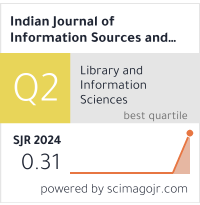Adoption and Use of Information and Communication Technologies by Educated Elderly People in Ibadan Metropolis, Nigeria
DOI:
https://doi.org/10.51983/ijiss.2015.5.1.418Keywords:
Information, Communication, Technology, Use, Educated, ElderlyAbstract
Information and Communication Technologies (ICTs) offer opportunities and challenges in providing support and in enhancing the daily lives of older people. This study investigated the adoption and use of ICTs and the factors that influence the usage by the educated elderly in Ibadan metropolis, Nigeria. Convenience and snowball techniques were used to select the sample, while questionnaire was used to collect data from the respondents. The study found that the respondents were using mobile phones and computers, and that majority of them used both devices daily. The activities that the elderly used ICTs to perform are voice calling, phone messaging and e-mail. The study reveals that the children of the elderly, spouse and advertisement were the major factors that influenced the adoption and use of ICTs by the elders. The educated elderly people agreed that ICTs adoption and use has a lot of benefits. Cost of acquiring and maintaining ICTs was chosen as the major barrier they are facing in using ICTs. The study recommends that it is favourable to design ICTs that meet the needs and wants of the elderly people in addition to ensuring the ICTs are easy to use by this group of people.
References
Ajzen, I. (1991). The theory of planned behaviour. Organizational Behavior and Human Decision Processes, 50(2), 179-211.
Andrianaivo, M., & Kpodar, K. (2011). ICT, financial inclusion and growth: Evidence from African countries. IMF Working Paper WP/11/73, 1-47.
Apulu, I., & Latham, A. (2011). An evaluation of the impact of information and communication technologies: Two case study examples. International Business Research, 4(3), 1-9. Retrieved January 6, 2015, from http://www.ccsenet.org/ibr doi:10.5539/ibr.v4n3p3
Birkland, J. L. H. (2012). A mixed bag: How work and retirement influence older adults’ ICT use. In SIGMIS-CPR ’12 Proceedings of the 50th Annual Conference on Computers and People, 127-130. doi:10.1145/2214091.2214126.
Charles, S. T., & Piazza, J. R. (2007). Memories of social interactions: Age differences in emotional intensity. Psychology & Aging, 22(2), 300-309. doi:10.1037/0882-7974.22.2.300
Charness, N., & Boot, W. R. (2009). Aging and information technology use: Potential and barriers. Current Directions in Psychological Science, 18(5), 253-258.
Chen, K., & Chan, A. H. S. (2011). A review of technology acceptance by older adults. Gerontechnology, 10(1), 1-12. doi:10.4017/gt.2011.10.01.006.00
Chen, K., Chan, A. H. S., & Chan, S. C. (2012). Gerontechnology acceptance by older Hong Kong people. Gerontechnology, 11(2), 102-111. doi: http://dx.doi.org/10.4017/gt.2012.11.02.524.00
Conci, M., Pianesi, F., & Zancanaro, M. (2009). Useful, social and enjoyable: Mobile phone adoption by older people. In Human-Computer Interaction – INTERACT 2009, 63-76. doi:10.1007/978-3-642-03655-2_7.
Czaja, S. J., Guerrier, J. H., Nair, S. N., & Landauer, T. K. (1993). Computer communication as an aid to independence for older adults. Behaviour and Information Technology, 2(4), 197-207.
Davis, F. D. (1989). Perceived usefulness, perceived ease of use, and user acceptance of information technology. MIS Quarterly, 13(3), 319-440.
Davis, F. D. (1993). User acceptance of information technology: System characteristics, user perceptions, and behavioral impacts. International Journal of Man Machine Studies, 38, 475-487.
de Sain, R. (2011). Harnessing technology to improve old age. Retrieved June 11, 2014, from http://www.ehealthspace.org
Eilers, M. (1989). Older adults and computer education: Not to have a closed door. International Journal of Technology and Aging, 2(1), 57-76.
Eggermont, S., & Vandebosch, H. (2008). Towards the desired future of elderly and ICT: Policy recommendations based on a dialogue with senior citizens. Paper presented at the annual meeting of the International Communication Association, Sheraton New York, New York City, NY, Oct. 10, 2009.
European Commission. (2010). Why is ICT for ageing well important? Overview of the European strategy in ICT for ageing well. Retrieved May 31, 2013, from ec.europa.eu/information_society/activities/.../ageing/overview. pdf
European Commission. (2012). Active ageing and solidarity between generations – A statistical portrait of the European Union. Luxembourg: Publications Office of the European Union, 1-141. doi:10.2785/17758
Frolik, L. (1996). The special housing needs of older persons. Stetson Law Review, 26, 647-666.
Gaßner, K., & Conrad, M. (2010). ICT enabled independent living for elderly: A status-quo analysis on products and the research landscape in the field of Ambient Assisted Living (AAL) in EU-27. In M. Conrad (Ed.), Institute for Innovation and Technology (IIT), 1-94.
Grazzi, M., & Vergara, S. (2012). ICT in developing countries: Are language barriers relevant? Evidence from Paraguay. Information Economics and Policy, 24, 161-171. doi:10.1016/j.infoecopol.2011.11.001
Goyal, V. C., & Dixit, U. (2008). Technology for safety and protection of elderly. In S. Bhatia, M. Cherian, & J. R. Gupta (Eds.), Protection of life and property of senior citizens in India, All India Senior Citizens’ Confederation (AISCCON), Navi Mumbai.
Irizarry, C., & Downing, A. (1997). Computers enhancing the lives of older people. Australian Journal on Ageing, 16(4), 161–165.
Karimi, & Neustaedter, C. (2011). My grandma uses Facebook: Communication practices of older adults in an age of social media (Technical Report, Simon Fraser University, 2011-1116-04).
Keil, M., Beranek, P. M., & Konsynski, B. R. (1995). Usefulness and ease of use: Field study evidence regarding task considerations. Decision Support Systems, 13, 75-91.
Kim, Y. S. (2008). Reviewing and critiquing computer learning and usage among older adults. Educational Gerontology, 34, 709–735. doi: 10.1080/03601270802000576
Lawhon, T., Ennis, D., & Lawhon, D. C. (1996). Senior adults and computers in the 1990s. Educational Gerontology, 22(2), 193–201.
Lee, S-G. (2003). An integrative study of mobile technology adoption based on the technology adoption model, theory of planned behaviour and diffusion of innovation theory (Unpublished doctoral dissertation, University of Nebraska).
Lenhart, A. (2009). Adults and social network websites. Pew Internet and American Life Project, January 14, 2009. Retrieved March 10, 2014, from http://www.pewInternet.org/Reports/2009/Adults-and-Social-Network-Websites.aspx
Li, N., & Kirkup, G. (2007). Gender and cultural differences in Internet use: A study of China and the UK. Computers and Education, 48(2), 301-17.
Liu, C.-J., & Yang, S. C. (2014). Using the technology acceptance model to examine seniors’ attitudes toward Facebook. International Scholarly and Scientific Research and Innovation, 8(6), 936-941.
Liu, W. (2015). A hybrid model for explaining older adults' continuance intention toward SNSs. International Journal of Smart Home, 9(1), 93-102. http://dx.doi.org/10.14257/ijsh.2015.9.1.10
Loges, W., & Jung, J. (2001). Exploring the digital divide: Internet connectedness and age. Communication Research, 28(4), 536–562.
Longe, O., Boateng, R., Longe, F., & Olatubosun, K. (2010). Information and communication technology adoption among adults in South Western Nigeria: An assessment of usage-phobia factors. Journal of Information Technology Impact, 10(1), 65-86.
McCloskey, D. W. (2006). The importance of ease of use, usefulness, and trust to online consumers: An examination of the technology acceptance model with older consumers. Journal of Organisational and End User Computing, 18(3), 47-65.
Melander-Wikman. (2008). Ageing well - Mobile ICT as a tool for empowerment of elderly people in home health care and rehabilitation (Doctoral Thesis, Luleå University of Technology, Department of Health Science, Division of Health and Rehabilitation), Luleå, 1-169.
Miskelly, F. G. (2001). Assistive technology in elderly care. Age and Ageing, 30, 455-458.
Morris, M. G., & Venkatesh, V. (2000). Age differences in technology adoption decisions: Implications for a changing workforce. Personnel Psychology, 53(2), 375–403.
Näsi, M., Räsänen, P., & Sarpila, O. (2012). ICT activity in later life: Internet use and leisure activities among senior citizens in Finland. European Journal of Ageing, 9(2), 169-176.
Nef, T., Ganea, R. L., Müri, R. M., & Mosimann, U. P. (2013). Social networking sites and older users – a systematic review. International Psychogeriatric Association. doi:10.1017/s1041610213000355
Nistelrooij, L. V. (2010). ICT and ageing: Building the silver economy. In E. Mordini & P. de Hert (Eds.), Ageing and Invisibility, USA: IOS Press.
Nwosu, B. C., & Ogbomo, N. (2011). ICT in education: A catalyst for effective use of information. PNLA Quarterly, The Official Publication of the Pacific Northwest Library Association, 1-6.
Opara, S., & Ituen, I. (2011). Nigeria’s ICT sector: Growth, gains, and challenges. COMPUWORLD, 1-5.
Pan, S., & Jordan-Marsh, M. (2010). Internet use intention and adoption among Chinese older adults: From the expanded technology acceptance model perspective. Computers in Human Behavior, 26(5), 1111-1119.
Pedlow, R., Kasnitz, D., & Shuttleworth, R. (2010). Barriers to the adoption of cell phones for older people with impairments in the USA: Results from an expert review and field study. Journal of Technology and Disability, 22(3), 2-15.
Phang, C. W., Sutanto, J., Kankanhalli, A., Li, Y., Tan, B. C. Y., & Teo, H.-H. (2006). Senior citizens’ acceptance of information systems: A Study in the context of e-government services. IEEE Transactions on Engineering Management, 53(4), 555-569.
Ray. (2009, October 4). Global voices. Retrieved June 6, 2014, from http://globalvoicesonline.org/2009/10/04/
Richardson, M., Weaver, C. K., & Zorn, T. E. (2004). Getting on: Older New Zealanders’ perceptions of computing. New Media and Society, 7(2), 219-245. doi:10.1177/1461444805050763.
Richardson, M., Zorn, T. E., & Weaver, J. K. (2002). Seniors’ perspectives on the barriers, benefits and negative consequences of learning and using computers (Working Paper). Department of Management Communication, Waikato Management School, Hamilton, New Zealand.
Richardson, M., Zorn, T., & Weaver, C. K. (2007, May 23). Not “getting on”: Older non-users’ meanings for computers. Paper presented at the Annual Meeting of the International Communication Association, TBA, San Francisco, CA.
Roberts, P. (2001). Electronic media and the ties that bind. Generations, 25(2), 96-98.
Sayago, S., Forbes, P., & Blat, J. (2012, June 3). Older people becoming successful ICT learners over time: Challenges and strategies through an ethnographical lens. Retrieved from http://www.dtic.upf.edu/~ssayag/SayagoForbesBlat_OlderPeopleICT_EducationalGerontology_AAV.pdf
Selwyn, N. (2004a). The information aged: A qualitative study of older adults' use of information and communications technology. Journal of Aging Studies, 18(4), 369-384. doi:10.1016/j.jaging.2004.06.008.
Selwyn, N. (2004b). Exploring the role of children in adults’ adoption and use of computers. Information Technology and People, 17(1), 53-70.
Selwyn, N., Gorard, S., Furlong, J., & Madden, L. (2003). Older adults' use of information and communications technology in everyday life. Ageing and Society, 23(5), 561-582.
Selwyn, N., & Gorard, S. (2008). What computers can’t do for you? Adults Learning, 19(6), 26-27.
Slegers, K., van Boxtel, M. P. J., & Jolles, J. (2012). Computer use in older adults: Determinants and the relationship with cognitive change over a 6-year episode. Computers in Human Behavior, 28, 1–10. doi:10.1016/j.chb.2011.08.003.
Su, S.-P., Tsai, C.-H., & Hsu, W.-L. (2013). Extending the TAM model to explore the factors affecting the intention to use telecare systems. Journal of Computers, 8(2), 525-532.
Timmerman, S. (1998). The role of information technology in older adult learning. In J. C. Fisher & M. A. Wolf (Eds.), Learning: Meeting the Challenges of Older Adulthood, New Directions for Adult and Continuing Education, San Francisco, CA, USA: Jossey-Bass, 77.
United States Census Bureau. (2008). Populations projections. Retrieved July 12, 2014, from http://www.census.gov/population/projections/data/national/2008.html
United Nations. (2009). World Population Ageing (ESA/P/WP/212). Retrieved from http://www.un.org/esa/population/publications/WPA2009/WPA2009_WorkingPaper.pdf
United Nations. (2001). World Population Prospects: The 2000 Revision.
United Nations. (2008). World Population Prospects: The 2008 Revision - Population Database.
United Nations. (2011). Current status of the social situation, well-being, participation in development and rights of older persons worldwide. Department of Economic and Social Affairs, New York. ST/ESA/339 United Nations, December 2011, pp. 98.
Venkatesh, V., & Davis, F. D. (2000). A theoretical extension of the technology acceptance model: Four longitudinal field studies. Management Science, 46(2), 186–204.
Venkatesh, V., Morris, M. G., Davis, G. B., & Davis, F. D. (2003). User acceptance of information technology: Toward a unified view. MIS Quarterly, 27(3), 425-478.
White, H., McConnell, E., Clipp, E., Bynum, L., Teague, C., Navas, L., Craven, S., & Halbrecht, H. (1999). Surfing the net in later life: A review of the literature and pilot study of computer use and quality of life. Journal of Applied Gerontology, 18(3), 358-378.
White, J., & Weatherall, A. (2000). A grounded theory analysis of older adults and information technology. Educational Gerontology, 26(4), 371-386.
World Health Organization (WHO). (2002). Active ageing: A policy framework. A contribution of the World Health Organization to the Second United Nations World Assembly on Ageing, Madrid, Spain, April 2002.
Wright, K. (2000). Computer-mediated social support, older adults, and coping. Journal of Communication, 50(3), 100-118.
Downloads
Published
How to Cite
Issue
Section
License
Copyright (c) 2015 The Research Publication

This work is licensed under a Creative Commons Attribution-NonCommercial-NoDerivatives 4.0 International License.









